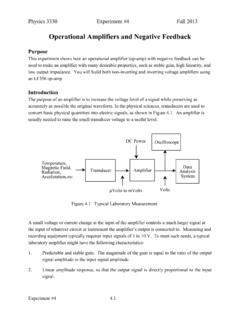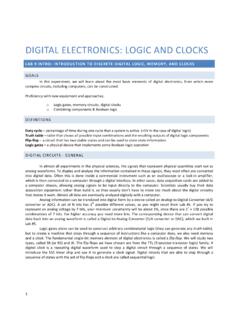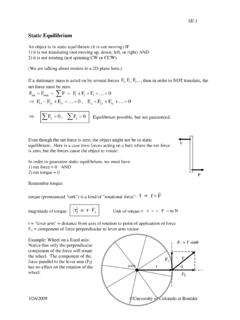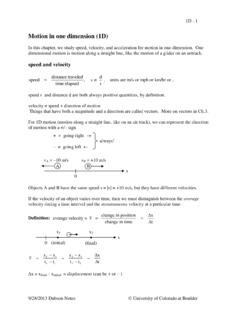Transcription of Rotational Motion - Physics
1 R-1 11/8/2013 University of Colorado at Boulder Rotational Motion We are going to consider the Motion of a rigid body about a fixed axis of rotation. The angle of rotation is measured in radians: s(rads) (dimensionless)r Notice that for a given angle , the ratio s/r is independent of the size of the circle. Example: How many radians in 180o? Circumference C = 2 r rs =radsrr rads = 180o, 1 rad = Angle of a rigid object is measured relative to some reference orientation, just like 1D position x is measured relative to some reference position (the origin). Angle is the " Rotational position". Like position x in 1D, Rotational position has a sign convention.
2 Positive angles are CCW (counter-clockwise). Definition of angular velocity: d = (rad/s)dtt , ( like dxxv , v dtt ) units rad = s In 1D, velocity v has a sign (+ or ) depending on direction. Likewise, for fixed -axis rotation, has a sign, depending on the sense of rotation. More generally, when the axis is not fixed , we define the vector angular velocity with direction = the direction of the axis + "right hand rule". Curl fingers of right hand around rotation, thumb points in direction of vector. v : (+) ( ) (+) ( ) s r s r s = r r x 0 x + x R-2 11/8/2013 University of Colorado at Boulder For Rotational Motion , there is a relation between tangential velocity v (velocity along the rim) and angular velocity.
3 S s = r r , rsv = = rtt v = r Definition of angular acceleration : 2d (rad/s )dtt , ( like dvva a dtt ,) Units: 2rad = s = rate at which is changing. = constant = 0 speed v along rim = constant = r Equations for constant : Recall from Chapter 2: We defined dxdvv = , a = dtdt , and then showed that, if a = constant, 0212002200v = va txxv ta tvv2 a xx () Now, in Chapter 10, we define dd = , = dtdt . So, if = constant, 0212002200 = ttt2 () Same equations, just different symbols. Example: Fast spinning wheel with 0 = 50 rad/s ( 0 = 2 f f 8 rev/s ).
4 Apply brake and wheel slows at = 10 rad/s. How many revolutions before the wheel stops? Use 2202 , final = 0 222005002125 rad22 10 () 1 rev125 rad19 9 rev2 rad . s in time t r R-3 11/8/2013 University of Colorado at Boulder Definition of tangential acceleration atan = rate at which speed v along rim is changing drdvda =rdtdtdt tan() atan = r atan is different than the radial or centripetal acceleration 2rvar ar is due to change in direction of velocity v atan is due to change in magnitude of velocity, speed v atan and ar are the tangential and radial components of the acceleration vector a. 22tanr| a |aaa Angular velocity also sometimes called angular frequency.
5 Difference between angular velocity and frequency f: # radianssec , # revolutionsfsec T = period = time for one complete revolution (or cycle or rev) 2 rad2TT , 1 rev1fTT 2f Units of frequency f = rev/s = hertz (Hz) . Units of angular velocity = rad /s = s-1 Example: An old vinyl record disk with radius r = 6 in = cm is spinning at rpm (revolutions per minute). What is the period T? 33 3 rev33 3 rev60 s60 33 3 s1 80 s/rev1min60 s33 3 rev1rev ..(/.).. period T = s What is the frequency f ? f = 1 / T = 1 rev / ( s) = Hz What is the angular velocity ? 12f20 555 s3 49 rad s (.)./ atan a ar R-4 11/8/2013 University of Colorado at Boulder What is the speed v of a bug hanging on to the rim of the disk?
6 V = r = ( cm)( s-1) = cm/s What is the angular acceleration of the bug? = 0 , since = constant What is the magnitude of the acceleration of the bug? The acceleration has only a radial component ar , since the tangential acceleration atan = r = 0. a = 222r0 530 m/sva1 84 m/sr0 152 m(.).. (about g's) For every quantity in linear (1D translational) Motion , there is corresponding quantity in Rotational Motion : Translation Rotation x dxvdt d = dt dvadt d = dt F (?) M (?) F = Ma (?) = (?) KE = (1/2) m v2 KE = (1/2) (?) 2 The Rotational analogue of force is torque. Force F causes acceleration a Torque causes angular acceleration The torque (pronounced "tork") is a kind of " Rotational force".
7 Magnitude of torque: r Fr Fsin r Fm N r = "lever arm" = distance from axis to point of application of force F = component of force perpendicular to lever arm axis r F F F = F sin F|| R-5 11/8/2013 University of Colorado at Boulder Example: Wheel on a fixed axis: Notice that only the perpendicular component of the force F will rotate the wheel. The component of the force parallel to the lever arm (F||) has no effect on the rotation of the wheel. If you want to easily rotate an object about an axis, you want a large lever arm r and a large perpendicular force F : Example: Pull on a door handle a distance r = m from the hinge with a force of magnitude F = 20 N at an angle = 30o from the plane of the door, like so: = r F = r F sin = ( m)(20 N)(sin 30o) = m N For fixed axis, torque has a sign (+ or ) : Positive torque causes counter-clockwise CCW rotation.
8 Negative torque causes clockwise (CW) rotation. If several torques are applied, the net torque causes angular acceleration: net Aside: Torque, like force, is a vector quantity. Torque has a direction. Definition of vector torque : rF = cross product of r and F: "r cross F" Vector Math interlude: The cross-product of two vectors is a third vector A BC defined like this: The magnitude of AB is A B sin . The direction of AB is the direction perpendicular to the plane defined by the vectors A and B plus right-hand-rule. (Curl fingers from first vector A to second vector B, thumb points in direction of AB r F = r F Another example: a Pulley axis no good!)
9 (r = 0) bad better best no good! (F = 0) + hinge F F r R-6 11/8/2013 University of Colorado at Boulder To see the relation between torque and angular acceleration , consider a mass m at the end of light rod of length r, pivoting on an axis like so: Apply a force F to the mass, keeping the force perpendicular to the lever arm r. acceleration atan = r Apply Fnet = m a, along the tangential direction: F = m atan = m r Multiply both sides by r ( to get torque in the game ): r F = (m r 2) Define "moment of inertia" = I = m r 2 = I ( like F = m a ) Can generalize definition of I: Definition of moment of inertia of an extended object about an axis of rotation: 222i i1 12 2iIm rm rm r.
10 Examples: 2 small masses on rods of length r: I = 2 m r2 axis r m A B A B axis F F axis ri m i axis m m r r R-7 11/8/2013 University of Colorado at Boulder A hoop of total mass M, radius R, with axis through the center, has Ihoop = M R2 222i iiiiIm rm RM R (since ri = R for all i ) In detail: 2222221 12 23 312322123Im rm rm rm Rm Rm RmmmRMR() A solid disk of mass M, radius R, with axis through the center: Idisk = (1/2) MR2 (need to do integral to prove this) See Appendix for I s of various shapes. Moment of inertia I is " Rotational mass". Big I hard to get rotating ( like Big M hard to get moving ) If I is big, need a big torque to produce angular acceleration according to net = I ( like Fnet = m a ) Example: Apply a force F to a pulley consisting of solid disk of radius R, mass M.





